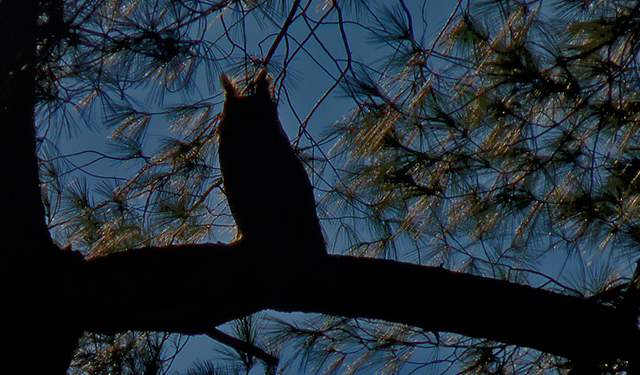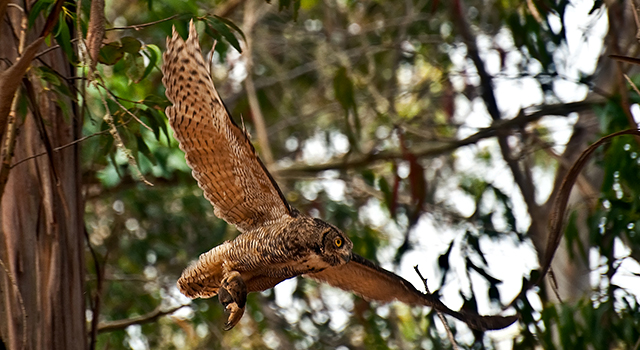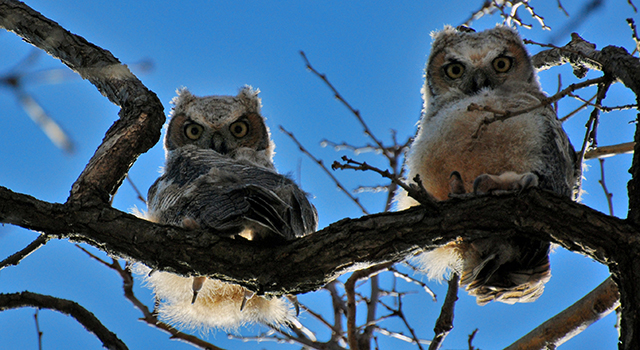With their intimidating size, silent flight, and penetrating gaze, it’s no wonder that the Great Horned Owl is so frequently associated with Halloween!
Many cultures viewed owls as a sign of impending doom. The ancient Romans, for example, viewed the owl’s nocturnal hunting habits as a sure sign it was a creature of the underworld and believed that owls were actually witches in disguise.

Photo: John B. on Flickr
Far from an evil monster, the Great Horned Owl (Bubo virginianus) is a large, beautiful owl native to Wisconsin. Its range runs from the northern Alaska to the eastern half of South America. It is a highly adaptable bird, commonly found in a variety of habitats ranging from forests and farmlands to around rivers and thick woods in urban and suburban areas. It is in fact the most common owl in North and South America.

Photo: Scott Costello
The Great Horned Owl has menacing yellow eyes and distinct feathery ear-like tufts (plumicorns) which lend it a devilish appearance. Its face has a brownish facial disk and is outlined with darker ruffs. Its body color can vary from light gray to rusty brown. Feathers run down both the legs and the feet of the Great Horned, making it seem as if it has little owl pantaloons.

This Great Horned Owl has caught dinner. Photo: Anita Ritenour
In the evening, Great Horned Owls hunt a wide variety of creatures, striking stealthily from above. They use their long, sharp talons to seize and kill prey which can be equal to or even larger than themselves.
Great Horned Owls are known to be devoted parents. Both the female and male owl will incubate their eggs and care for their young. Adult females typically lay between 2-5 eggs in the dead of winter. Owlets will leave the nest around 6 weeks of age and sometimes stay with their parents for as long as 9 months.

These owlets were part of a family that had taken up residence on the University of Wisconsin Campus.
Photo: Joshua Mayer
As a predator of various mice and rodents, Great Horned Owls provide helpful population control of species frequently regarded as pests by humans. Ironically humans are one of the only natural predators that owls have. Owls are often harmed after ingesting mice or animals that have been poisoned with insecticides or pesticides, or in collisions man-made structures.
Fun Facts:
- Eeeww! Great Horned Owls are thought to be one of the only animals that willingly hunt and eat skunks.
- Despite popular myth, owls can not turn their heads completely around their bodies. They can however, without moving their bodies, turn their heads 270 degrees in either direction to see behind their selves.
- Great Horned Owls have incredible hearing. Their ears are not located under their “horns” or “tufts,” but instead are located on either side of their face. Their hearing is so finely tuned that they can hear a mouse running in the snow at a distance.
- Soft fringe and comb-like feathers at the end of their wings helps reduce the sound of rushing wind and helps the Great Horned Owl become an even quieter hunter.
- Great Horned Owls have lots of common names. They are sometimes also referred to as “hoot owls” and “cat owls.”
- Many people often hear Great Horned Owls before seeing them. Their quintessential song is a two or three part hoot. Listen to them at the Cornell Lab of Orinthology website!
Top Photo: Susan Rachlin, U.S. Fish and Wildlife Service





